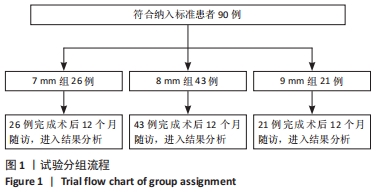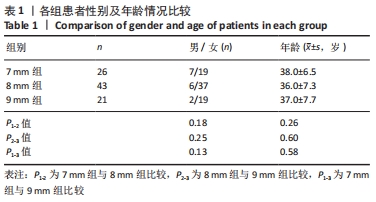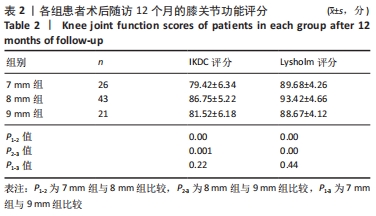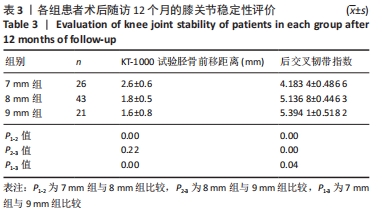中国组织工程研究 ›› 2022, Vol. 26 ›› Issue (34): 5482-5485.doi: 10.12307/2022.459
• 材料生物相容性 material biocompatibility • 上一篇 下一篇
前交叉韧带重建中移植物直径大小与膝关节功能的关系
罗学辉,杜绍龙
- 广州中医药大学附属佛山市中医院三水医院,广东省佛山市 528100
Relationship between graft diameter and knee function in anterior cruciate ligament reconstruction
Luo Xuehui, Du Shaolong
- Sanshui Hospital of Foshan Hospital of Traditional Chinese Medicine, Guangzhou University of Chinese Medicine, Foshan 528100, Guangdong Province, China
摘要:

文题释义:
后交叉韧带指数:在MRI斜矢状位图像上应用后交叉韧带指数来判断术后移植物与后交叉韧带撞击的程度,在膝关节MRI斜矢状位上画出2条线段A和B,B为后交叉韧带上、下止点中心点之间的连线,A为线段B与后交叉韧带之间的垂线,后交叉韧带指数=线段B长度/线段A长度,研究发现后交叉韧带指数与撞击程度呈正相关,即撞击程度越严重后交叉韧带指数越大。
背景:重建前交叉韧带后患者功能的康复与不同重建方式、前交叉韧带移植物形态及直径、不同前交叉韧带移植物类型等多种因素有关,相关临床研究认为移植物的直径在7-10 mm范围内,直径越大膝关节恢复功能越好、并发症越少。
目的:研究前交叉韧带重建移植物直径大小与患者膝关节功能的关系。
方法:选择广州中医药大学附属佛山市中医院三水医院2018年3月至2020年1月收治的前交叉韧带断裂患者90例,均采用自体肌腱进行前交叉韧带重建,根据自体肌腱编织后直径的大小分为7 mm组(n=26)、8 mm组(n=43)及9 mm组(n=21)。术后随访1年,应用IKDC评分及Lysholm评分评价患者膝关节功能,采用KT-1000试验及后交叉韧带指数评价患者膝关节稳定性。试验获得广州中医药大学附属佛山市中医院三水医院伦理委员会批准。
结果与结论:①8 mm组患者的IKDC评分及Lysholm评分均高于7 mm组、9 mm组(P < 0.05),7 mm组与9 mm组患者的IKDC评分及Lysholm评分比较差异均无显著性意义(P > 0.05);②7 mm组患者的KT-1000试验胫骨前移距离与后交叉韧带指数均大于8 mm组、9 mm组(P < 0.05),8 mm组患者的后交叉韧带指数小于9 mm组(P < 0.05),8 mm组与9 mm组KT-1000试验胫骨前移距离比较差异无显著性意义(P > 0.05);③结果表明对于单纯膝关节前交叉韧带损伤患者中,重建移植物直径8,9 mm有可获得良好的膝关节稳定性,重建移植物直径为8 mm可获得更好的膝关节功能,偏小或者偏大的移植物直径可能会对患者关节功能恢复带来某些因素的影响。
https://orcid.org/0000-0002-2829-8051 (罗学辉)
中国组织工程研究杂志出版内容重点:生物材料;骨生物材料; 口腔生物材料; 纳米材料; 缓释材料; 材料相容性;组织工程
中图分类号:




